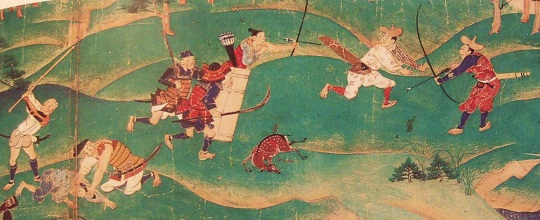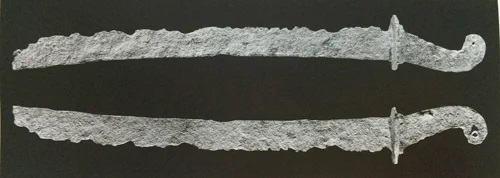Tsuruhashi (鶴嘴) - The Samurai's Warpick
Tsuruhashi (鶴觜) - The Samurai's Warpick
In the centre, an unarmored soldiers wearing a Tsuruhashi on a two handed shaft, with an hammer side and a white-hardened point, from the Ukiyo-e "Descending Gees at Yahagi Bridge" by Yoshitoshi, 1868
In this article I want to cover a dedicated anti armor weapon known as Tsuruhashi (Crane's beak ) also known as Motayu (藻弛) and often erroneously called nanban hachiwari (more of this later on).
This warpick was a percussive weapon which resemble an European warhammer or an Indian Zaghnal, both in shapes but also in usage as well.
The war pick was made of iron or steel, usually fitted onto a lacquered wooden handle that could vary in length; most of the time it was one handed, but there is at least one depiction showing it to be two handed length.
The one handed version occasionally had a "D-shaped" handguard on the handle.
Even if it was rare, it was used from the 14th century onward to overcome the coverage of body armor through blunt impact and by piercing the zones covered with mail or with thin plates, thanks to its prolonged beak.
It was also used to destroy gates, shields or other defensive implements used in the field, just like the masakari (鉞).
This warpick was a percussive weapon which resemble an European warhammer or an Indian Zaghnal, both in shapes but also in usage as well.
The war pick was made of iron or steel, usually fitted onto a lacquered wooden handle that could vary in length; most of the time it was one handed, but there is at least one depiction showing it to be two handed length.
The one handed version occasionally had a "D-shaped" handguard on the handle.
Even if it was rare, it was used from the 14th century onward to overcome the coverage of body armor through blunt impact and by piercing the zones covered with mail or with thin plates, thanks to its prolonged beak.
It was also used to destroy gates, shields or other defensive implements used in the field, just like the masakari (鉞).
On the right a warrior with a Tsuruhashi on its back, presumably one handed with an hammer side, from the original 14th century scroll "十二類巻物"
The majority of Tsuruhashi only had a peak without an "hammer side" although some artistic representations show a similar feature.
This weapon shouldn't be confused with the Kama (鎌) or the Tobiguchi (鳶口) although they share some similar features; the Kama has a blade rather than a spike, and the Tobiguchi, besides being also a tool that could be "weaponized", has a shorter beak and a top spike.
However, the "boundaries" in the nomenclature are rather slim; sometimes, a Tobiguchi could be considered a warpick, and in some example of the famous Kusari-gama, there is a beak instead of a blade which should make the weapon a Kusari-tsuruhashi but luckily nobody use such names to make things even harder in the world of arms and armor collectors.
Sometimes, a similar beak was fitted to some Yari, making the weapon highly effective in dealing against armor.
Sometimes, a similar beak was fitted to some Yari, making the weapon highly effective in dealing against armor.
On the left the warpick, in this case called Motayu (藻弛)); from "武器皕圖"
In fact, nobody knew its original name; this is what led some collectors of Tobiguchi to call this weapon a "foreign head-breaker" (Nanban hachiwari), since it resembled an European warhammer. However, this weapon existed before the contact with the European, so there is nothing "nanban" in this warpick.
Probably it was a derivative of the everyday pickax used by the Japanese (nowadays the name Tsuruhashi means "pickax"); just like the Kama or the Tobiguchi, from ordinary tools they were "weaponized" to be used effectively on the battlefield.
This weapon its highly effective in dealing with any type of armor, and is capable of overcoming even the highest form of protections.
Hope that this short but neat article was informative enough! For any questions there is a comment section below, and if you liked the article please feel free to share it!
Gunbai










Good article as usual, but how did it delivered blunt impact if it's a Warpick not a hammer wouldn't that damage it and I thought it was a common weapon for foot soldiers but if it's rare why was it rare seems like good and simple weapon to have on you.
ReplyDeleteHi Kevin is nice to see you here!
DeleteIf the pick has also a back side extending in the other direction of the pick, as you can see in the first picture, it can be used as an hammer; if it's just a pick, you still have to think that the weapon is a top heavy one, with all the weight focused on the top and given the fact that all the pressure would be directed into a single point (the beak) it would generate a lot of force: is the same principle that explain why axes could deliver blunt trauma, although the edge of an axe is larger and thus not as effective as a pick.
Well it is rare in the sense that the majority of the soldiers on the battlefield either used ranged weapons or more versatile polearms with a greater range. This however doesn't mean that the Samurai didn't carried one; and we also have to consider that we don't have the whole picture of the gears that those warriors used in the past. It might be more common than the evidences suggest us; as you know Japanese art is not very accurate in depicting battles!
What are the others weapons shown in the scroll?
ReplyDeleteHi and thank you for leaving a comment Junichiro!
DeleteI immagine that you are referring to the last picture, the "武器皕圖" scroll; starting from left to right, the second weapon is a mace called "Dou tsuki" (armor breastplate breaker)( I have also mentioned it in my article about the Kanasaibou: http://gunbai-militaryhistory.blogspot.com/2018/04/kanabou-samurais-mace.html ), the third is a Javelin called hyousou (presumably copied by some Ming military treatises since the name is the same), the fourth is a tube shaped chisel called tsutsunomi and the last one is a grappling hook called uchikagi; these two are tools rather than weapons and are also found in some Ninjutsu manuals as well as some Ming military manuals.
Thank you.
DeleteI posted this comment before reading the other article and out conversation.
I really need to learn japanese if i want to obtain some first hand knowledge
Since we are talking about blunt weapons,did you ever stumble upon a kind of mace called Te-Gi apparently used by the Edo police?
DeleteLearning Japanese is very hard, I'm actually still learning it myself; however, if you want to obtain some first hand knowledge you have to deal with Japanese sources.
DeleteThe name doesn't sound familiar to me; How is it written in Kanji?
I really don t know, i know nothing about this weapon more than his name and that brief description,someone suggested that it had a wooden handle and a metal head like a european mace, but i don t know the source.
DeleteI actually even doubt the existence of such weapon since i never found any type of reference to it anywhere execpt forums,but i want to ask since there was the possibility you knew something about it
I have never heard about it, although the description resembled the Dou Tsuki in the article I made about the Kanabo.
DeleteI won't be surprised to see that some variations of the Kanabo used during the feudal periods were indeed very similar to European maces; the Japanese had also access (in a very limited way) to Korean and Chinese weapons too, and a mace is a very simple tool to design in my opinion.
Anyway, If I'll find something more I'll write about it!
Looking at it again,i have found it in George Cameron Stone "Glossary of the Construction,Decoration and use of Arms and Armor in all continents" , with the description: Te-Gi, a kind of mace formerly carried by japanese police. Stop. Nothing more on the net. I wonder if it was a variation of the Dou Maru,or a completely different thing,we don't have an historical period nor a place other than Japan. Now i really wonder. If only we had a physical image of the Dou Maru to compare,maybe we could see if it is similar.
DeleteHello, may I ask you a question? I have seen and I even posest a copy of a ukiyo-e showing two samurai fighting with red face paint. I also seen a same aucurence in a 15th century painting of a battlefield were only two samurai on foot have it. My question is where those face painting used in war and if so what is their name or are they just kumadori showing a theatrical hero?
ReplyDeletehttp://pinterest.com/pin/830210512534452959/?source_app=android à
Feel free to ask questions whenever you want to!
DeleteI have seen many war manuals describing in details the various type of banners like uma jirushi or sashimono, and even some describing the etiquette of the feudal warriors, but I have never seen anything like war face painting.
That type of paint is called suji kuma if I recall correctly and it's from the 17th century, but I might be wrong because I'm not well versed in Japanese theater.
The Samurai of the 16th century were a lot into aesthetic, they used Kawari kabuto after all; but I don't see any purpose in using that type of war paint when mempo were available.
However, some make up was used to make the head "presentable" if it was taken by the enemy and we have references of horses being painted in the 14th century, so I'm not 100% sure that this wasn't used at all. Maybe some warriors did, but surely it wasn't common.
I just finded this picture of the onin war, not sure when it was made but we can clerely see that one of the clan has red paint on the face, when the others don't. I suppose it throws away the possibility of being theatrical depiction but rather being something from this clan http://www.fujiarts.com/japanese-prints/k146/94k146f.jpg
DeleteI saw the picture and I have to say that the style is the same of the Ukiyo-e made in the 18th and 19th century; in fact, the castle depicted in the background is a much later style of the ones of the Onin war period. I won't consider this picture a proof that war paint were used, although again it might be that some Samurai in the feudal period of Japan painted their faces, but it's highly unlikely in my honest opinion
DeleteHi Gunbai! As always, enjoy your articles. My question is:
ReplyDeleteHow many surviving examples do we have of tsuruhashi? And from what age? An where can I find them?
Thank you in advance.
Hello and welcome to my blog! I'm glad you liked my article!
DeleteTo answer your question: there aren't many examples actually, is a very rare weapon; I have seen 3 or 4 examples which are actually inside private collection. They are dated Edo period, but they could be earlier. If you want to see some real examples, type Nanban Hachiwari on google - although the wrong name, is the keyword to access to the right images on the net.
Thank you very much for the answer. I found the pictures, and it is very interesting.
ReplyDelete